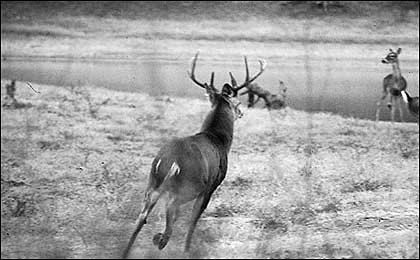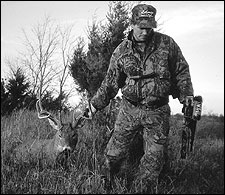October 28, 2010
By Gary Clancy
Each Fall Whitetail Bucks Engage In Brief But Foolish Games Of Pursuit
By Gary Clancy
 Having worked themselves into a frenzy making scrapes, but with the breeding portion of the rut still well away, bucks begin pressing does. This brief period during the fall results in some incredibly intense deer movement when buck sightings increase dramatically. |
Back in my high school days I played a little third base. There was a skinny kid from one of the neighboring schools who gave me fits. The kid batted right-handed and was a straight pull hitter. I mean, this kid had never hit a ball to right in his life. The kid would step up to the plate, dig in, wave the lumber and then cock his head a bit to stare at me over his left shoulder. If I shifted toward the bag, the skinny kid would slap one through the gap between me and the shortstop. The next time the kid came up I would make sure I covered that hole and the kid would drill one right over the bag. Every time we played that team, the skinny kid made me look bad.
I got to thinking about those old high school games and the skinny kid after an exciting, but frustrating, day of bowhunting in northeast Iowa. It was the second week of November, the 10th to be precise. The morning was one of those you dream about--clear, cold and so calm you could hear a field mouse expel gas at 100 yards. It was one of those mornings when you can just feel it, know what I mean? Something good was going to happen on this day.
Advertisement
Twice in the 20 minutes it took for shooting light to seep out of the night sky I heard deer running in the timber below the ridge on which I perched. It was so still that the deer sounded like they were right under the wind-twisted oak to which I had strapped my stand, but they were actually far below along the tired, little creek. The light was still murky when I heard another deer coming my way. The doe blasted from the edge of the woods, darted into a field of set aside and came running full-tilt right at my tree along the seam where frost-coated grass met dark timber. Right behind her came a hog-fat, heavy-horned, wide-shouldered Iowa mega-buck. In an instant the doe blew right past my tree, with the buck chugging along 20 yards behind. I drew and grunted at the buck with my mouth to get him to stop. If he heard me, he sure didn't acknowledge it. I let out a loud blaaat! He kept right on motoring. Flustered now, I swung with him, hit the release and watched the yellow and white fletching disappear into the grass six feet behind his fat rear end.
I was still kicking myself for taking a shot I know better than to take when another doe came running full-tilt over a gentle hill in the open field. Behind her were a pair of immature bucks, both looking to be basket-racked eight-points. The trio darted into a finger of brush jutting into the field about 200 yards south of my perch and then disappeared. The next hour was quiet.
Advertisement
Soon I heard deer running again, this time behind me. It was another doe being chased by a buck. They ran below my stand in the heavy timber and then came squirting out that same finger of brush the threesome had run into an hour earlier. Through binoculars I studied the buck as he hot-footed after the doe across the field. Not huge, but a nice buck, long tines but lacking the mass of a mature animal. I started to think about moving my stand to that brushy draw. An hour later, having seen no more deer, I did just that.
I planned to hunt all day; might as well be in the best spot, right? Right! Guess where the next deer I saw walked? Yup, right under that oak I had just vacated. Nice buck too and walking, not running. By dark I had seen three more bucks, although I think two of them were the same eight-points I had seen cross the field earlier. One of them ran a doe in circles around that oak in which I had spent most of the morning. Kind of reminded me of how I felt when that skinny kid kept slapping that ball through the holes where I used to be.
That's the chase phase for you. Lots of action, but trying to pick the precise stand location to best take advantage of that activity will drive you nuts.
 During most of the rut the author is partial to using buck decoys to lure whitetails; however, during the chase phase he finds that a doe decoy gets better results. He likes to make sure the decoy is easily visible from a number of directions. |
WHY THEY CHASE
There are two main periods to the annual whitetail rut--the scraping period and the breeding period. In the northern half of the whitetail's range, these two periods are well-defined, because the breeding period occurs at a predictable time each year and is short and intense in duration. This is nature's way of ensuring that the fawns will be dropped late enough in the spring to miss those deadly spring blizzards, but not so late that the youngsters are too small to make it through their first winter. In the southern states, where it is not critical that does give birth during a short and specific period, the breeding tends to be drug out over weeks and in some cases months, making it impossible to predict the timing of the main periods of the rut, much less the chase phase.
In those areas with a well-defined rut, the chase phase occurs at the tag end of the scraping period and just prior to the first wave of does entering estrus. The bucks have worked themselves into a frenzy by this time. They are primed and ready for action. To ensure that a doe has a buck already on the hook when she is ready to be bred, does begin to give off scent signals a day or two prior to actually entering estrus. These signals are picked up by the bucks, and the chase is on. Of course the doe is not ready to stand for the buck yet, so the doe has to stay on the move constantly. When you get multiple does in this condition in your hunting area, you are in for a real circus. When it comes to seeing numbers of deer, both bucks and does, no other time compares with the short, but intense chase phase of the rut.
SETTING A DATE
Because the chase phase is short-lived, timing it is critical. Fortunately, predicting when the chase phase will occur is not difficult. The peak of the breeding period, which is a five-to-seven-day-long whitetail orgy during which about 70 percent of the does are bred, falls on about the same dates annually. Granted, the moon phase, the weather, herd condition and hunting pressure can all have an influence on the exact timing and the intensity of daytime movement during the breeding period, but the dates will not vary by more than a few days in either direction from year to year. Nearly all game and fish departments will be able to furnish you with the dates of the peak of the breeding period in the state you are hunting.
Once you know that the
peak of the breeding period is from, let's say, November 15-20 in the state you are hunting, you can bet that the chase phase is going to occur sometime in the week prior to the beginning of the peak of breeding. In this case I would be looking for chase phase action between November 8-15. Don't expect the chase phase to last the entire eight days, however. A couple of days of nonstop chasing is more the norm, but the chase phase will occur sometime during this time period; the exact timing depending upon the dates of the peak of breeding for that year.
BOWHUNTING TACTICS
The chase phase is one of my favorite times to be in the woods. If you are in decent whitetail country, seeing deer is almost a sure thing. However, seeing deer is the easy part. Setting up so that one of those bucks saunters by within bow range is the frustrating part of hunting the chase phase. Whitetail deer are unpredictable critters most of the time anyway, but when you've got a bunch of sex-crazed bucks chasing unwilling, frightened does around, the unpredictability factor skyrockets. I don't have any sure cures, but here are some of the things that have worked for me.
 The results of a successful hunt during the chase period. If you can hunt all day at this time, by all means do so. It's a certainty the bucks will be doing the same. |
Use a doe decoy. I do a lot of hunting over decoys and usually I prefer a buck decoy, but during the chase phase, because bucks tend to rush up to every doe they see, I've found that a doe decoy or two draws more attention than a buck decoy. Be sure the doe decoy is easily visible. Field edges, clear-cuts, logging roads, natural woodland openings and tree-studded pastures are all good bets. The more directions from which a buck can spot the decoy and the greater the distance, the more bucks your decoy will attract.
Use a good doe-in-estrus urine. Don't put it right on the decoy, however. If you do, the odor will get on your clothing when you handle the decoy; and you don't want to be smelling like a doe-in-heat and draw attention to yourself. I like to jab a stick in the ground at the rear of the decoy and place a cotton ball or scent wick saturated with scent on the stick. Some guys just pour the scent on the ground, but I think the cotton ball or wick holds the scent longer. You don't need the urine to attract the buck to the decoy, but the urine will hold the buck's attention for a long time and allow you to get the perfect angle for the shot.
Hunt funnels. That's worn advice, I know, but it is still valid. A buck may wander through the funnel in his search for does, or a harassed doe may pull a buck through the funnel behind her. Either way, you are a winner.
Hunt food sources. If you know where the does are doing most of their feeding, that is the place to be when the chase phase is in progress. The bucks know these places too; and although they could care less about eating, they will cruise through these whitetail cafeterias hoping to catch a doe or two chowing down. Great places for a decoy too.
Do a lot of calling and rattling. Right now is prime time to grunt in or rattle up a buck. The bucks are going bonkers, and it does not take much to convince them that they are missing out on some hot action when they hear what they think is another buck giving the tending grunt or two bucks fighting.
If you can, hunt all day. Sure, the action is most intense morning and evening, but bucks are cruising for does all day long during this period. If you are going to take a break, do it between about 1:30 and an hour before sunset; in my experience this is the period of least movement. I suppose the deer have to rest sometime, even during the chase phase.
